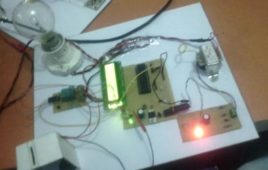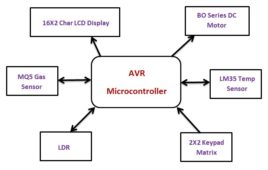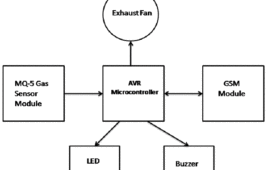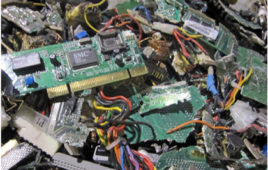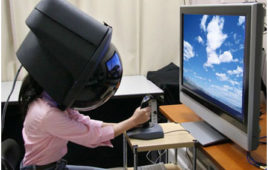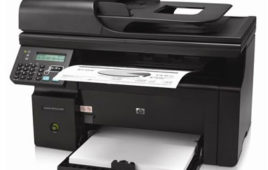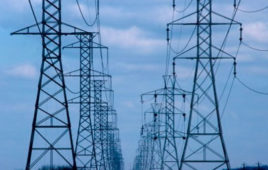Saving electricity is a major concern for domestic and industrial units. We always try hard to save electricity in many ways to reduce our electricity bills, but due to some known and unforeseen circumstances our efforts do not normally transform in saving electricity. Adding to our woes we may at times forget to switch off electrical gadgets when we are not using them, especially the AC’s, which not only results in mounting electricity bills, but also forget the fact that we are wasting a resource which is of National Importance.
Latitude & Longitude Display System Using GPS & AVR Microcontroller- (Part 44/46)
This project is a reference to budding engineers or a helping hand to those who willing to work and interface a GPS Receiver with microcontroller and making their own channel to communicate with satellite, seeking for some useful information from satellite to make a effective and efficient system. Before we check all the details of this project, here is the final implemented circuit diagram of longitude and latitude display system using GPS and AVR microcontroller.
Smart Home Automation using AVR
In this technological world, automatic systems are being preferred over manual system. In this series Home Automation plays an important role for humans. In this unit we talk about basic needs to understand the project well and also for its future advancements. We are going to talk about different types of sensors (i.e. Temperature Sensor, LPG Gas Sensor, LDR) and input and output devices (i.e. 2×2 matrix Keypad, Buzzer, DC Motor, 16×2 Char LCD Display, Power Supply section etc.).Now we are going to Interface all those with the brain of the system ‘Microcontroller (i.e. ATmega16/16L)’ and let’s find out what the individual role of each component are and how they act as Smart Home System together. In this project I used three analog sensors i.e. Temp, LPG Gas and LDR. These are given analog output. Read more to find out how the circuit looks like and what is the code.
Microcontroller Based LPG Gas Leakage Detector using GSM Module
The presence of dangerous LPG leakage in the cars, service station or in the storage tank environment can be detected using the Ideal Gas Sensor. This LPG gas leakage detector unit can be easily integrated into a unit that can sound an alarm or give a visual suggestion of the LPG concentration. The sensor has…
Electronic Waste or E-Waste
Have you ever given a thought what happens when you throw or sell your old cell phone or personal computer? Where does it go? And how it affects the atmosphere? Electronic waste or e-waste are those electrical and electronic items that are no longer usable or have been replaced by the new generation version. Computers, cell phones, televisions, refrigerators, air conditioners, DVDs, iPods, copiers, and fax machines are common electronic products, which eventually turn to e-wastes. According to researchers nearly 75 percent of old electronic products are dumped in storage because of the uncertainty of how to manage these materials. Although many of these materials can be reused, refurbished, or recycled but unfortunately they are not, thus making the electronic discards as one of the fastest growing segments of world’s waste stream.
Virtual Reality
Go…Go….Go…Roger FIRE in the hole!….Fire in the hole!!!….Two down…TWO DOWN…one more one more… YOU LOST!!!While pressing the keys of your keyboard or keypad to convert the lost games to last moment victories the chances are you have encountered the virtual reality in your life. These games involve you with the characters or objects and with the amplification of the involvement, one feels a part of this virtual world. By using 3D imagery with a head mounted device (HMD) and high quality surrounding sound equipments, these games creates more involvement in the virtual world and consequently shut down the cues of real world. This is what is called virtual reality, which has applications far beyond gaming.Virtual reality can be defined as an upcoming technology that makes users feel in a Virtual Environment (VE) by using computer hardware and software.
What is IPTV
Televisions have been the prime source of entertainment since their commercialization. New display technologies as well as the content over the TV channels are continuously enhancing the user experience since its invention. In the twenty first century, mobile and internet technologies have revolutionized the entire civilization. Televisions have also been influenced by the internet technology. The conventional methods to serve the television programs like cables, satellite or broadcasting are getting replaced with the broadband cables used for internet. IPTV is a system where digital television services are delivered over the internet by using Internet Protocol. The video channels and programs are delivered to the television sets through a broadband connection, instead of being delivered through the conventional cable or broadcast formats.
Computer Monitors – CRT, LCD, LED, Plasma & OLED Display Monitors
A computer monitor, technically termed as visual display unit is an output device that presents the information from the CPU on the screen working as an interface between CPU and the user. A cable connects the monitor to a video adaptor or video card which is set up on the motherboard of the computer. The CPU (Central Processing Unit) sends instruction to the video adaptor telling what needs to be displayed on the screen. The video adaptor converts the instructions into a set of corresponding signals and sends to the monitor. Monitor contains a circuitry that generates the picture on the screen from the set of signals. The major parameters that measure the performance of a monitor are luminance, contrast ratio, resolution, dot pitch, response time, refresh rate and power consumption. The common problem that arises in monitors is dead pixels, blurred screen, phosphor-burn, etc.
Printers : Daisy Wheel, Dot Matrix, Inkjet Printers & Laser Printers
A printer is an electromechanical device which converts the text and graphical documents from electronic form to the physical form. Generally they are the external peripheral devices which are connected with the computers or laptops through a cable or wirelessly to receive input data and print them on the papers. Since the invention of the printing technology, a variety of technologies have been employed in computer printers. Broadly printers are categorized as impact and non impact printers. Impact printers are the type of printers in which a key strikes the paper to make a letter. The examples of Impact printers are Daisy wheel and Dot matrix printers. While non-impact printers do not operate by striking a head against a ribbon. Inkjet printers and laser printers are the non-impact printers.
Power Line Carrier Communication (PLCC)
Different communication technologies are being used for the transmission of information from one end to another depending on the feasibility and needs. Some include Ethernet cables, fiber optics, wireless transmission, satellite transmission, etc. A vast amount of information travels through the entire earth every day and it creates an essential need for a transmission medium that is not only fast but economically reasonable as well. One of the technologies that fit in this criteria is PLCC. PLCC, Power line carrier communication, is an approach to utilize the existing power lines for the transmission of information. In today’s world every house and building has properly installed electricity lines. By using the existing AC power lines as a medium to transfer the information, it becomes easy to connect the houses with a high speed network access point without installing new wirings.

